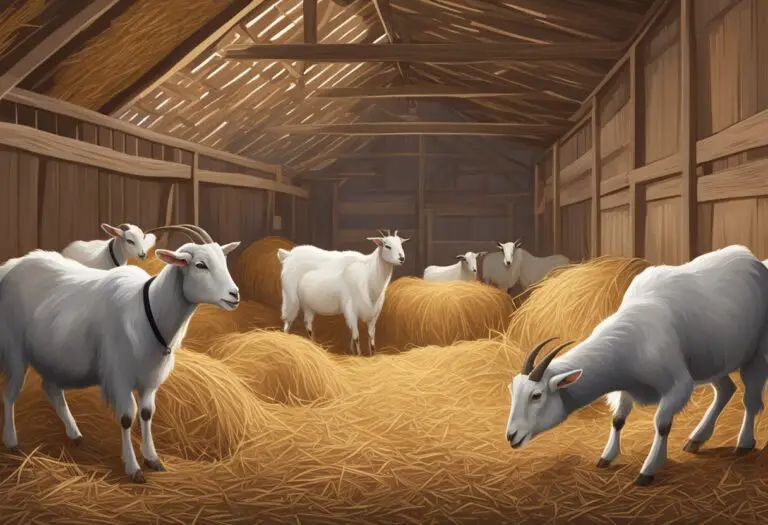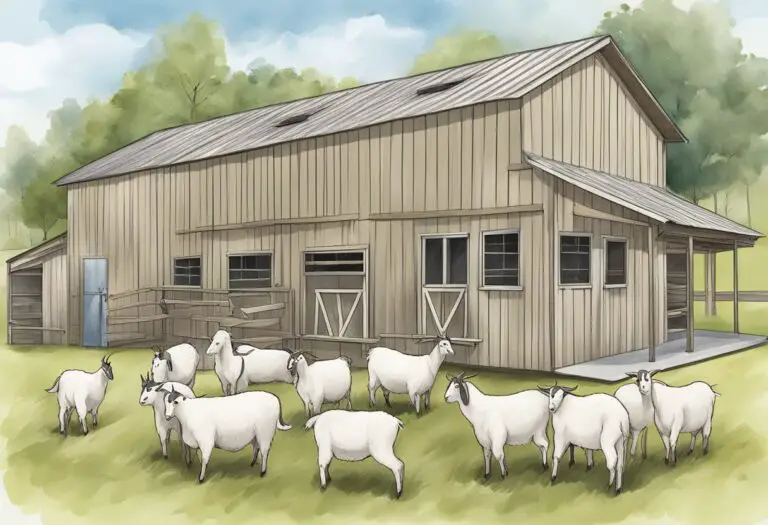Is Proper Goat Housing Important for Their Health?
Proper goat housing is a crucial aspect of goat farming that is often overlooked. Goats are hardy animals that can adapt to different environments, but they still require a comfortable and safe living space to thrive. The housing conditions can affect their health, productivity, and overall well-being. Therefore, it is important for goat farmers to understand the significance of proper goat housing and take necessary measures to provide their animals with suitable accommodations.
One of the primary reasons why proper goat housing is important is to prevent the spread of diseases. Goats are susceptible to various illnesses, and their living conditions can either enhance or hinder their immune system. A poorly ventilated or overcrowded barn can lead to respiratory problems, while a damp or dirty environment can cause skin infections or parasites. Moreover, goats are social animals that need enough space to move around, play, and interact with each other. Inadequate housing can lead to stress, aggression, and other behavioral problems that can affect their health and productivity.
Fundamentals of Goat Housing

Proper goat housing is crucial to ensure the health and well-being of your goats. A well-constructed goat house can provide shelter from harsh weather conditions, protect them from predators, and prevent the spread of diseases.
When designing a goat house, it is important to consider the following factors:
- Size: The size of the goat house should be based on the number of goats you have. Each goat should have at least 15-20 square feet of indoor space and 20-25 square feet of outdoor space.
- Ventilation: Good ventilation is essential to prevent the buildup of moisture and harmful gases. Adequate ventilation can be achieved through windows, vents, and fans.
- Lighting: Goats require natural light to maintain their circadian rhythm. The goat house should have windows or skylights to allow for natural light.
- Flooring: The flooring should be non-slip and easy to clean. Concrete, dirt, or gravel are all suitable options.
- Fencing: A secure fence is necessary to keep predators out and goats in. The fence should be at least 4-5 feet tall and made of sturdy materials.
- Bedding: Goats require a dry and comfortable place to rest. Bedding material such as straw, wood shavings, or sand can be used.
Overall, proper goat housing is an essential component of goat care. A well-designed goat house can provide a safe and comfortable environment for your goats, which can lead to improved health and productivity.
Impact of Housing on Goat Health

Goats are hardy animals that can adapt to various environments, but proper housing is essential for their health and well-being. Housing not only provides shelter from harsh weather conditions but also plays a crucial role in disease prevention, stress reduction, and temperature control.
Disease Prevention
Goats are susceptible to various diseases and parasites that can affect their health and productivity. Proper housing can help prevent the spread of diseases by providing a clean and hygienic environment. Housing should be well-ventilated, with adequate drainage and waste management systems to prevent the buildup of manure and urine. This reduces the risk of bacterial and fungal infections that can cause respiratory diseases, foot rot, and other health issues.
Stress Reduction
Stress can have a significant impact on goat health, affecting their immune system and overall well-being. Housing that provides adequate space, comfortable bedding, and protection from predators can help reduce stress levels in goats. Goats also benefit from social interaction with other goats, so housing should allow for group housing or at least visual and auditory contact with other goats.
Temperature Control
Goats are sensitive to temperature changes and can suffer from heat stress or hypothermia if exposed to extreme temperatures. Proper housing should provide insulation and ventilation to regulate temperature and humidity levels. This can be achieved through the use of shade structures, fans, and ventilation systems. In colder climates, housing should also provide adequate bedding, shelter, and protection from drafts to keep goats warm and dry.
In conclusion, proper housing is essential for maintaining the health and well-being of goats. Disease prevention, stress reduction, and temperature control are all critical factors that should be considered when designing and maintaining goat housing. By providing a clean, comfortable, and safe environment, goat owners can ensure the health and productivity of their animals.
Housing Design Requirements

Proper housing design is crucial for the health and well-being of goats. In order to ensure that goats are healthy and happy, there are several key design requirements that must be met.
Space Considerations
Goats require adequate space to move around and exercise. The minimum recommended space per goat is 20 square feet for adult goats and 10 square feet for kids. However, it is important to note that more space is always better. Providing goats with ample space will reduce stress and prevent the spread of disease.
Ventilation and Air Quality
Proper ventilation is essential for maintaining good air quality in goat housing. Poor air quality can lead to respiratory problems and other health issues. To ensure good ventilation, it is important to provide adequate air exchange and to avoid overcrowding. Additionally, it is important to keep the housing clean and free of excess moisture and manure.
Bedding and Flooring
Goats require clean, dry bedding to rest on. Bedding should be changed regularly to prevent the buildup of bacteria and other harmful organisms. Additionally, the flooring in goat housing should be slip-resistant and easy to clean. Concrete floors are a popular choice for goat housing because they are durable and easy to sanitize.
Overall, proper housing design is essential for the health and well-being of goats. By following these key design requirements, goat owners can ensure that their animals are healthy and happy.
Maintenance of Goat Shelters

Goat shelters are an essential aspect of goat farming. Proper maintenance of goat shelters is necessary to ensure the health and well-being of the goats. The following subsections detail the necessary maintenance practices for goat shelters.
Regular Cleaning
Regular cleaning of goat shelters is crucial to maintain a healthy and hygienic environment for the goats. It is recommended to clean the goat shelters at least once a week. The cleaning process involves removing all the bedding, manure, and debris from the shelter. Afterward, the shelter must be swept, scrubbed, and disinfected with a suitable disinfectant. The bedding must be replaced with fresh, clean bedding.
Shelter Repairs
Goat shelters must be adequately maintained to ensure they remain in good condition. Regular inspection of the shelter is necessary to identify any damage or wear and tear. Damaged or worn-out parts must be repaired or replaced immediately to prevent further damage to the shelter and ensure the safety of the goats. The roof, walls, and floor of the shelter must be checked regularly for any leaks, cracks, or holes.
Parasite Control
Parasites can cause significant health problems for goats. Proper parasite control measures must be implemented to prevent infestations. Regular cleaning of the shelter is necessary to remove any potential breeding grounds for parasites. The use of appropriate insecticides and dewormers can also help control parasites. It is recommended to consult a veterinarian to determine the best parasite control measures for the goats.
In conclusion, proper maintenance of goat shelters is essential to ensure the health and well-being of the goats. Regular cleaning, shelter repairs, and parasite control are necessary maintenance practices that must be implemented to maintain a healthy and hygienic environment for the goats.
Location and Environmental Factors

Goats are adaptable animals, but proper housing is essential to ensure their health and well-being. The location and environmental factors of a goat’s housing can significantly impact their health.
Access to Grazing Area
Goats are natural grazers and require access to a grazing area to maintain their health. A grazing area should provide ample space for the goats to move around and graze comfortably. The area should be free from poisonous plants and have access to clean water.
Protection from Predators
Goats are prey animals and are vulnerable to predators. Proper housing should protect them from potential predators such as coyotes, dogs, and foxes. The housing should be sturdy and secure, with fencing that is high enough to prevent predators from jumping over.
Weather Adaptations
Goats are adaptable to different weather conditions, but their housing should provide protection from extreme weather conditions. The housing should be well-ventilated to prevent moisture buildup and provide adequate insulation to keep the goats warm during cold weather. In hot weather, the housing should provide shade and access to cool water to prevent heat stress.
In conclusion, proper goat housing is essential for their health and well-being. The location and environmental factors of the housing should be carefully considered to ensure that the goats have access to a grazing area, protection from predators, and adequate protection from extreme weather conditions.
Case Studies on Goat Housing

Proper goat housing is important for their health and well-being. Here are a few case studies that illustrate the importance of proper housing for goats.
Case Study 1: Poor Housing Conditions Lead to Health Problems
A group of goats were housed in a small, poorly ventilated barn with inadequate space for them to move around. The barn was also damp and had a high humidity level. As a result, the goats developed respiratory problems and skin infections. The owner had to spend a lot of money on veterinary bills to treat the sick goats.
Case Study 2: Proper Housing Improves Milk Production
A farmer who kept his goats in a clean, well-ventilated barn with ample space and proper lighting noticed a significant increase in milk production. The goats were also less prone to health problems and required less medication than before. The farmer was able to sell more milk and make a higher profit as a result.
Case Study 3: Shelter from Extreme Weather Conditions
During a harsh winter, a group of goats were housed in a barn with inadequate insulation and ventilation. The goats were exposed to extreme cold and dampness, which led to respiratory problems and frostbite. In contrast, a group of goats housed in a well-insulated and ventilated barn with proper bedding and heating remained healthy and comfortable throughout the winter.
In conclusion, these case studies demonstrate the importance of proper goat housing for their health and well-being. Providing adequate space, ventilation, lighting, insulation, and bedding can improve milk production, prevent health problems, and reduce veterinary bills.
Best Practices for Goat Housing

Proper housing is essential for the health and well-being of goats. Here are some best practices for goat housing:
1. Provide Adequate Space
Goats need enough space to move around freely and exercise. The amount of space required depends on the breed and size of the goat. As a general rule, each goat should have at least 20 square feet of indoor space and 200 square feet of outdoor space.
2. Ensure Proper Ventilation
Good ventilation is crucial for preventing respiratory problems in goats. Proper ventilation helps to remove moisture, ammonia, and other harmful gases from the housing area. It also helps to regulate temperature and humidity levels.
3. Maintain Cleanliness
Goats are susceptible to diseases and infections if their living area is dirty. Regular cleaning and disinfecting of the housing area is essential to prevent the spread of diseases. It is also important to remove manure and soiled bedding daily.
4. Provide Adequate Lighting
Goats need adequate lighting to maintain their natural circadian rhythm. Good lighting also helps to prevent injuries and accidents in the housing area. Natural light is preferred, but if not available, artificial lighting can be used.
5. Use Appropriate Bedding
Goats need a comfortable and dry place to rest. Appropriate bedding materials include straw, wood shavings, or sand. Avoid using materials that are toxic or harmful to goats.
By following these best practices for goat housing, owners can ensure that their goats remain healthy and happy.







